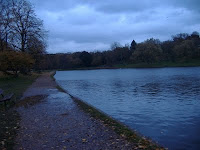| Women's Coronation Procession 1911 - copyright Museum of London |
Gibbin House - an excerpt
“How did it all start? Oh dear…well, I suppose it’s all due to Lysander.”
Alfred rose from his chaise, as if he were about to recite a gospel, and sat on the sofa arm beside their guest.
“You see, he’s the gentleman I told you about earlier, the owner of the house. We were at Cambridge together. We kept in touch, and when I returned to London in 1930 from my teaching stint in Vienna, he offered me rooms here. His mother, Mrs. Morrison was in need of a little company. She was a very lively, pragmatic, capable sort of woman – very English. Eventually, realizing I was much more at home here than I ever had been in Austria, I decided to become a British national and stayed on at Gibbin House. I could teach in the city, and Lysander always had a friend to visit on holidays. It was an arrangement that suited everyone very well. Of course, after the Anschluss, it happened that from time to time some old friend or other, on his way to somewhere in the Americas, might pass through. And Mrs. Morrison was very inclined to help the disenfranchised. In her earlier days, she had been a suffragette. There is a picture I’ll show you later in one of the upstairs halls, of Mrs. Morrison leading with her banner at the Coronation Procession in 1911.”
“Followed by an exquisite contingent from the Crown Colonies, delicious things,” Emil mused. (Page 63)
And here they are - the exquisite contingent: Indian suffragettes, captured in a moment of tremulous hope, on a summer's day one hundred years ago, almost to the week.
I serendipitously fell upon this postcard at the Museum of London in 2004, when I was trying to get a sense of a bygone England any way I could.
It's not easily done. In 1949, at the time my story takes place, the South African novelist Doris Lessing talked in her book 'In Pursuit of the English' at length about the difficulty of defining the English character as an outsider. And W.H. Maugham makes a similar point in 'Razor's Edge' about how non-English writers can never quite reproduce the English cadence and subtleties, forever sounding just a little off, a little pastiched.
But I never deluded myself into thinking I could capture a war era English atmosphere with any sense of complete authenticity, no matter how much I researched. Moreover, I was very aware of the period stereotypes I might be tempted to raid, from the multitudes of Agatha Christie mysteries and BBC costume dramas I regularly gorge on. Particularly regarding the women - the dowdy housekeepers, the pub slappers, the East End parlor maids, the skeletal debuttantes with ghostly complexions. Just the thought of this retinue makes me want to summon Poirot to discover who really poisoned the squire's afternoon tea. And what happened to the second will?
All the same, from the onset of my creating the English characters in the story, I knew our Mrs. Morrison had to be one of these proverbial figures - the Edwardian suffragette
I reasoned that as the deceased former owner of Gibbin House, Mrs. Morrison had to serve as a sort of invisible compass , a reminder of the dedication and temerity the present characters can't seem to embody. The brassy type of woman who would roll up her sleeves and 'just get on with it'.
And then I saw this photo, this brilliant bit of truth and reality.
| The Winslow Boy -Sony Pictures |
Instead of the hard nail militant English woman one might expect in 1911 London, it gave quite another face to the suffragette figure I was complacently imagening. It held a small key to the possiblity that Mrs. Morrison could indeed have existed as the charitable, judicious, and embracing woman I needed her to have been to give rise to Gibbin House in the first place.
I have often glanced at this photo during my years writing this book, even when it had nothing at all to do with the parts I was working on. I felt mezmerized by the exotic beauty of these women in silks and gauze (as our good Emil was, even if he does call them 'things'). I kept thinking - there they stand, weeks of ship travel behind them, unaccompanied and surrounded by police escorts and royal officers, no doubt coming across the very vocal opposition to their cause that was typical of the day, all to march for the right to vote. They are inspiring and something of a marvel, but then, I suppose I never cease to be amazed by acts of social courage.
So, though I may not be as adroit at performing them myself, in the spirit of the civil triumphs of this past week, I salute these daring, interpid women. Let's see what the next hundred years bring...
(For a good film portrayal of a British suffragette, watch Mamet's version of the 'Winslow Boy - I reference the original in the book's first chapter, but the 1999 version with the divine Jeremy Northam is incisive and charming. Incidentally, the director of the 1948 version is Anthony Asquith, who shares the same last name with the 1910s British Prime Minister who instigated the militant behavior of the suffragette movement, when at the last minute he withdrew his support for the women's vote because he feared women would not reelect him...)











